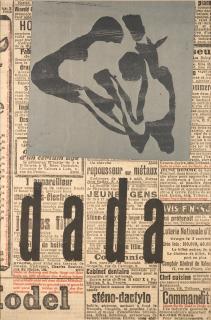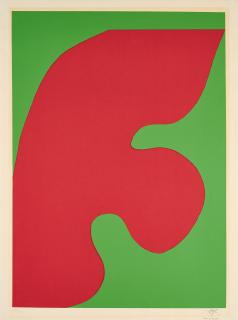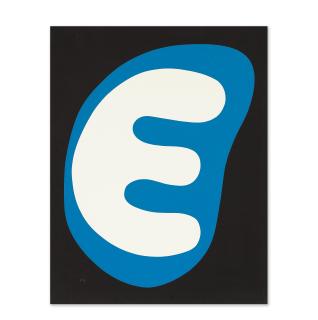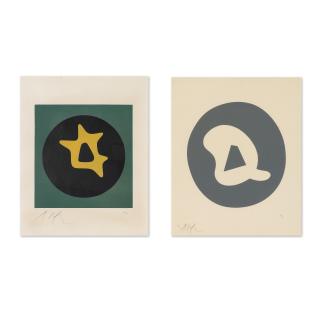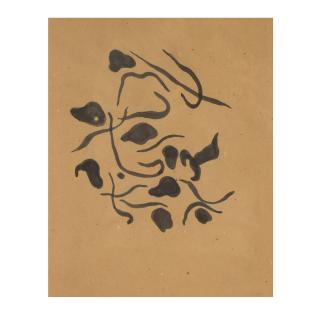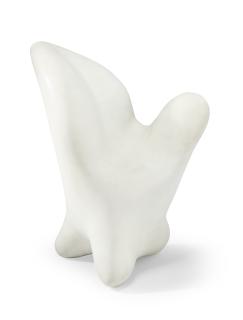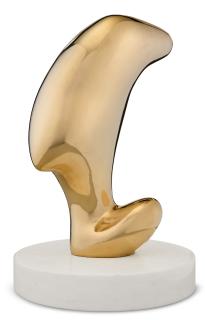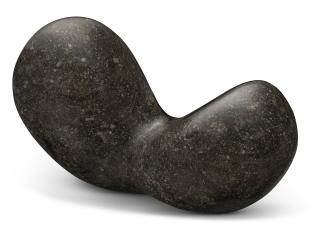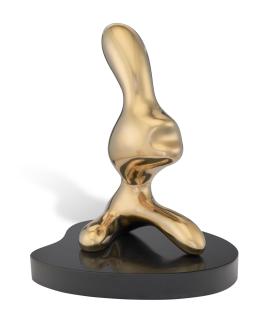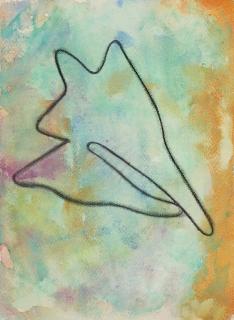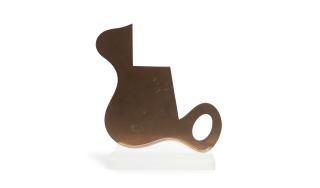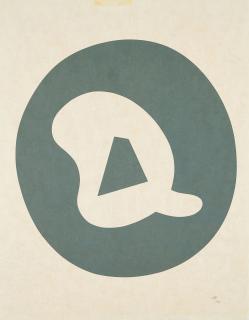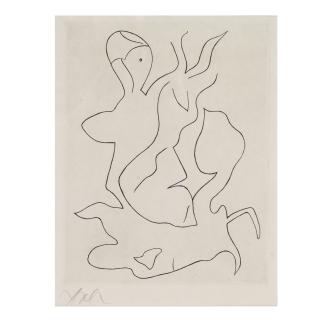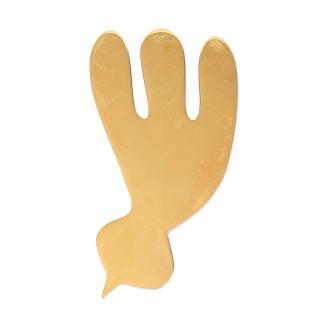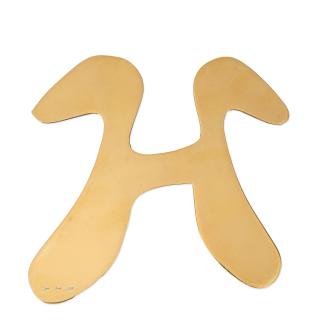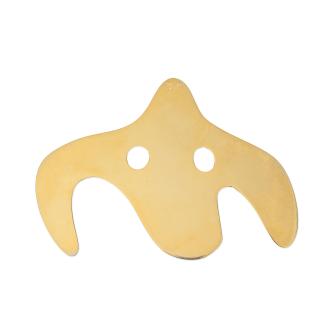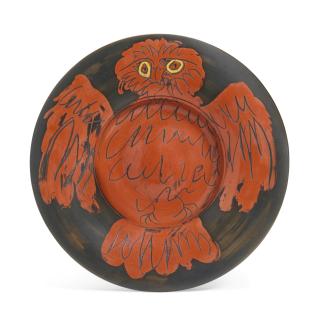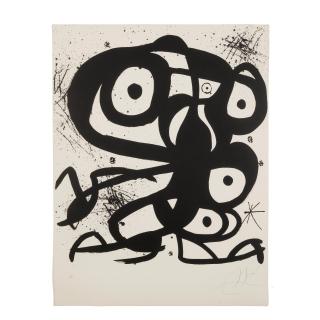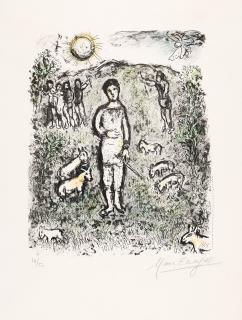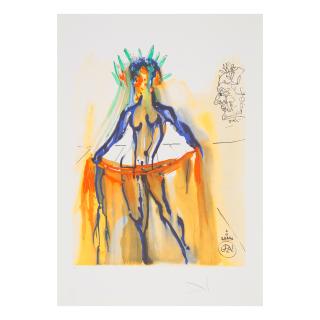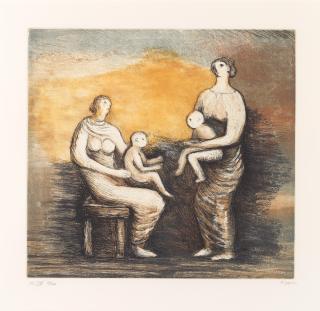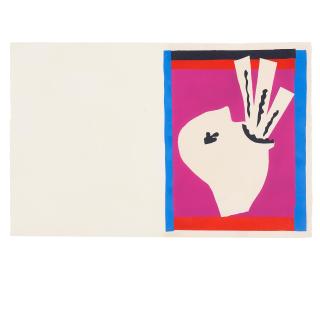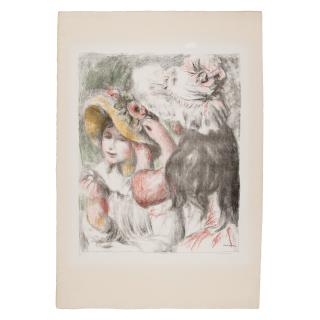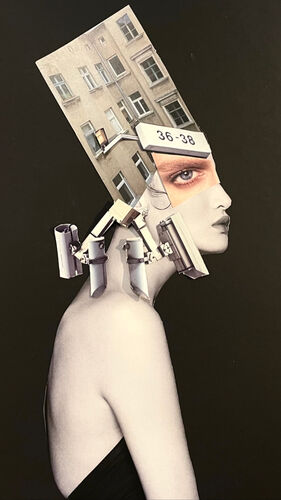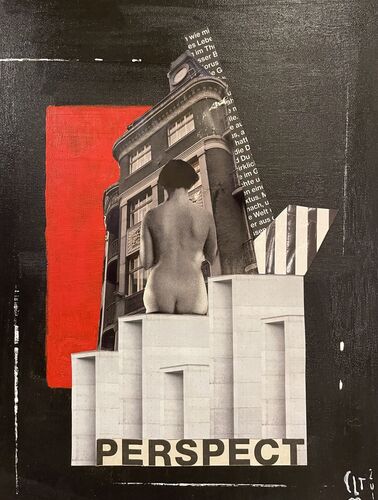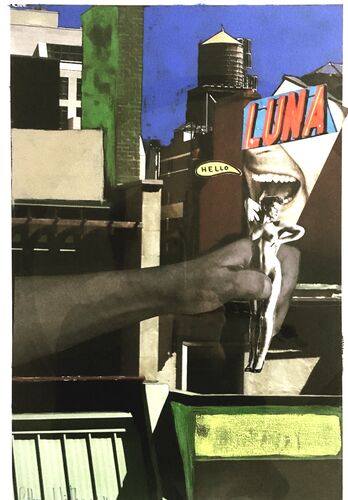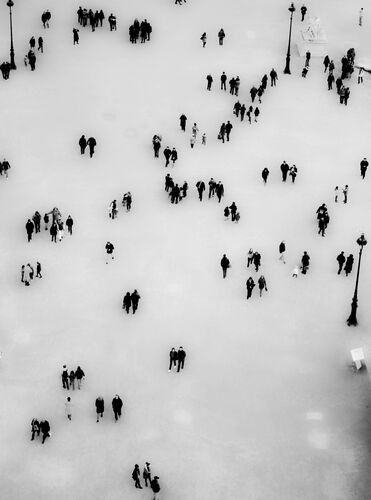Jean (Hans) Arp Strasbourg, France 1886 - 1966 Basel, Switzerland
The artist Jean (Hans) Arp
- German-French painter, graphic artist, sculptor and lyricist.
- One of the most important artists of Dadaism and Surrealism.
- Considered one of the co-founders of Dadaism and was a member of many artist groups.
Born in Strasbourg on 16 September 1886 under the name Hans Peter Wilhelm Arp, the painter, graphic artist, sculptor and lyricist Arp is considered one of the most relevant artists of Dadaism and Surrealism. The son of a German father and a French mother used his first name Hans in the German-speaking world and Jean in the French-speaking world.
Arp studied fine arts at the art school in Weimar and at the Académie Julian in Paris from 1904 to 1908. Around 1910 he was briefly in contact with Wassily Kandinsky and other artists from the circle of the Blaue Reiter through Paul Klee. Shortly afterwards he moved to Zurich, where he became a co-founder of the Swiss artists' association Moderner Bund in 1911. In 1915, Arp's work was shown there for the first time and a year later he founded Dadaism in Zurich in cooperation with Marcel Janco, among others. It was also during this period that he met the painter, sculptor, textile designer, architect and dancer Sophie Taueber-Arp and collaborated with artists such as El Lissitzky and Kurt Schwitters. In 1919, Arp moved to Cologne, where he met Max Ernst and Johannes Theodor and founded Cologne Dadaism with them.
Three years later, he married Sophie Taueber-Arp, with whom he created a large number of art works in the course of his life. In 1926 they moved to Strasbourg, where they both took French citizenship. They became members of the artist movement Cercle et Carré and co-founders of the Parisian abstract artist group Abstraction-Création.
During this time, the Arps maintained regular contact with the painter couple Sonia Terk and Robert Delaunay and became friends with artists such as Joan Miró, Wolfgang Paalen, Florence Henri and Marcel Duchamp. Sophie's death in 1943 threw Arp very much off course; he dedicated a large number of his artworks to her.
Arp's oeuvre is strongly influenced by the Dadaist principle of chance. Also noticeable are the organic-harmonic, natural and rounded forms that are still considered characteristic of his artwork today. While at the beginning of his career he mainly worked as a painter and graphic artist and created many illustrations, collages, pictures made of fabric and paper as well as colourful wooden reliefs, in the second half of his life he turned to Surrealism and from the 1930s onwards increasingly devoted himself to sculptures. In 1950, he designed several large sculptures for various international universities and the UNESCO building in Paris.
In 1954, he was awarded the International Prize for Sculpture at the Venice Biennale for his sculptural works. Three years later, a first monograph was dedicated to him, and the following year the Museum of Modern Art in New York City showed a retrospective. His art was also exhibited at documenta 1 (1955), documenta II (1959) and documenta III (1964). Hans Arp died in Basel on 7 June 1966 at the age of 80. His artwork is now part of the collections of the Tate Gallery (London), the Solomon R. Guggenheim Museum (New York) and the Art Institute of Chicago, to name a few.
Der Künstler Jean (Hans) Arp
- Deutsch-französischer Maler, Grafiker, Bildhauer und Lyriker.
- Zählt zu den wichtigsten Künstlern des Dadaismus und Surrealismus.
- Gilt als ein Mitbegründer des Dadaismus und pflegte Kontakte zu vielen Künstlergruppen.
Am 16.09.1886 in Straßburg unter dem Namen Hans Peter Wilhelm Arp geboren, gilt der Maler, Grafiker, Bildhauer und Lyriker Arp als einer der relevantesten Künstler des Dadaismus und Surrealismus. Als Sohn eines deutschen Vaters und einer französischen Mutter nutzte er den Vornamen Hans im deutschen und Jean im französischen Sprachraum.
Arp studierte von 1904 bis 1908 bildende Kunst an der Kunstschule in Weimar und an der Académie Julian in Paris. Um 1910 stand er durch Paul Klee kurzzeitig in Kontakt zu Wassily Kandinsky und anderen Künstlern aus dem Umfeld des Blauen Reiters. Kurz darauf zog er nach Zürich, wo er 1911 zum Mitbegründer der Schweizer Künstlervereinigung Moderner Bund wurde. 1915 wurden Arps Werke dort erstmals ausgestellt und ein Jahr darauf begründete er in Zürich u. a. mit Marcel Janco den Dadaismus. Ebenfalls in dieser Zeit lernte er die Malerin, Bildhauerin, Textilgestalterin, Architektin und Tänzerin Sophie Taueber-Arp kennen und kollaborierte überdies mit Künstlern wie El Lissitzky und Kurt Schwitters. 1919 zog Arp nach Köln, lernte hier Max Ernst sowie Johannes Theodor kennen und begründete mit ihnen den Kölner Dadaismus.
Drei Jahre später heiratete er Sophie Taueber-Arp mit der er im Verlauf seines Lebens eine Vielzahl an Werken schuf. 1926 zogen sie nach Straßburg, wo beide die französische Staatsbürgerschaft annahmen. Sie wurden Mitglieder der Künstlerbewegung Cercle et Carré und Mitbegründer der abstrakten Pariser Künstlergruppierung Abstraction-Création.
Während dieser Zeit pflegten die Arps regelmäßige Kontakte zum Malerehepaar Sonia Terk und Robert Delaunay und freundeten sich mit Künstlern wie Joan Miró, Wolfgang Paalen, Florence Henri und Marcel Duchamp an. Der Tod Sophies im Jahre 1943 warf Arp sehr aus der Bahn, er widmete ihr eine Vielzahl seiner Werke.
Das Œuvre Arps ist stark vom dadaistischen Prinzip des Zufalls geprägt. Auffallend sind zudem die organisch-harmonischen, naturnahen und gerundeten Formen, die bis heute als charakteristisch für seine Werke gelten. Während er zu Beginn seines Schaffens vorwiegend als Maler und Grafiker in Erscheinung trat und viele Illustrationen, Collagen, Bilder aus Stoff und Papier sowie bunte Holzreliefs schuf, wandte er sich in der zweiten Hälfte seines Lebens dem Surrealismus zu und widmete sich ab den 1930ern vermehrt Plastiken. So entwarf er 1950 mehrere Großplastiken für verschiedene internationale Universitäten und das UNESCO-Gebäude in Paris.
1954 wurde er für seine plastischen Arbeiten auf der Biennale von Venedig mit dem Internationalen Preis für Skulptur ausgezeichnet. Drei Jahre später wurde ihm eine erste Monografie gewidmet, im Jahr darauf zeigte das Museum of Modern Art in New York City eine Retrospektive. Außerdem wurden seine Arbeiten auf der documenta 1 (1955), der documenta II (1959) und der documenta III (1964) ausgestellt. Hans Arp starb am 07.06.1966 im Alter von 80 Jahren in Basel. Seine Arbeiten gehören heute u. a. zu den Sammlungen der Tate Gallery (London), des Solomon R. Guggenheim Museum (New York) und des Art Institute of Chicago.
Jean (Hans) Arp in a nutshell
With his abstract sculptures and sculptures, Jean (Hans) Arp renewed the prevailing standards of sculpture for the rest of the 20th century. In the summer of 1917, he stayed at Lake Maggiore, where the flotsam inspired him to create biomorphic forms. His woodcuts and reliefs increasingly took on organic forms and became more important to his work. In the 1920s, under the influence of Dadaism, he first deepened his interest in wooden sculptures that could hang or stand.
His first round sculptural works in plaster followed in the 1930s. Arp referred to his biomorphic sculptures of human form (such as the Torso) as Human Concretion - they manage without a defined standing surface and allow for variations in placement. His later bronze sculptures led to conflicts in 2008, 42 years after Arp's death, when it was discovered that there were no secured re-casting rights for the forms and doubts arose about the authenticity of some of the works from the Hans Arp und Sophie Taeuber-Arp e. V. Foundation. Until rights were clarified in 2015, Arp exhibitions were halted internationally.
The significance of his biomorphic sculptures is manifold. The behavior of the respective materials, the feting of the mass, aroused great interest in Arp. He called these processes "tension de sol" (ground tension), which, moreover, alludes to the constancy of natural cycles. The origin of life, the place of man within creation and the "making visible of an invisible" are themes that moved Arp to the sculptures.
Jean Hans Arp is considered a co-founder of Dada, for example, he surrounded himself with avant-garde contemporaries such as Kurt Schwitters, El Lissitzky and Max Ernst. Arp did not exclusively pursue the forms of Dadaism, but moved in the spheres of all relevant interwar genres such as Constructivism, Neo-Plasticism and Surrealism.
Jean-Hans Arp collages can be understood as two types of work. On the one hand, he published the poetry book die Wolkenpumpe (the Cloud Pump) which contains his famous Textcollagen (text collages, 1920) on the other hand, he began to produce physical collages, the Papiers déchirés (torn paper) from 1930. In reshaping the torn paper, he allowed chance and transience to rule. In the 1910s he was already working on very similar works, with the difference that here he arranged squares rather than shapeless pieces of paper. Although many works from this period are very similar, a work made of imprecise blue squares is one of the most famous collages: Untitled (Collage with Squares Arranged according to the Law of Chance) (1916-17) belongs to the collection of the MoMa in New York.
Jean Hans Arp created several paintings, especially during his great experimental phase in the 1910s, but he also integrated the medium into his creative process again and again later on. Arp's paintings, like all his works, follow an abstract scheme. While the almost three-dimensional Abstract Composition (1915) captivates with strong warm hues, his very late The Sun Recircled (1966) appears in grays and pastels. Although some of his paintings, like his sculptures, take on biomorphic features and bear names such as Before my Birth (1914) or Femme (1927), no figurative paintings by Jean (Hans) Arp are known.
Works by Jean Hans Arp have been an integral part of the Museum of Modern Art in New York since the 1950s. The museum held a comprehensive retrospective of the Strasbourg-born artist in 1958. Today, the Moma has an extensive inventory of various Hans Arp works, from which it regularly presents parts in group and individual shows.
Häufige Fragen zu Jean (Hans) Arp
Mit seinen abstrakten Plastiken und Skulpturen erneuerte Jean (Hans) Arp die vorherrschenden Standards der Skulptur für das restliche 20. Jahrhundert. Im Sommer 1917 hielt er sich am Lago Maggiore auf, wo das Treibgut ihn zu biomorphen Formen inspirierte. Seine Holzschnitte und Reliefs nahmen immer häufiger organische Formen an und erhielten einen höheren Stellenwert für sein Schaffen. In den 1920er Jahren, unter dem Einfluss des Dadaismus, vertiefte er zunächst sein Interesse für Holzskulpturen, die hängen oder stehen konnten.
Erste rundplastische Arbeiten aus Gips folgten in den 1930er Jahren. Seine biomorphen Skulpturen menschlicher Form (so wie der Torso) bezeichnete Arp als Menschliche Konkretion – sie kommen ohne definierte Standfläche aus und lassen Aufstellungsvarianten zu. Seine späteren Bronzeplastiken führten 2008, 42 Jahre nach Arps Tod zu Konflikten, als man feststellte, dass es keine gesicherten Nachgussrechte für die Formen gab und Zweifel an der Authentizität einiger Arbeiten aus der Stiftung Hans Arp und Sophie Taeuber-Arp e. V. aufkamen. Bis zur Klärung der Rechte 2015 stellte man Arp-Ausstellungen auf internationaler Ebene ein.
Die Bedeutung seiner biomorphen Skulpturen ist vielfältig. Das Verhalten der jeweiligen Materialien, das Fetswerden der Masse, weckte großes Interesse bei Arp. Er nannte diese Prozesse »tension de sol« (Bodenspannung), was zudem an die Beständigkeit der Naturzyklen anlehnt. Der Ursprung des Lebens, der Platz des Menschen innerhalb der Schöpfung und die »Sichtbarmachung eines Unsichtbaren« sind Themen, die Arp zu den Plastiken bewegten.
Jean Hans Arp gilt als Mitbegründer des Dada, umgab er sich etwa mit avantgardistischen Zeitgenossen wie Kurt Schwitters, El Lissitzky oder Max Ernst. Arp verfolgte nicht ausschließlich die Formen des Dadaismus, sondern bewegte sich in den Sphären aller relevanten Zwischenkriegsgenres wie dem Konstruktivismus, dem Neo-Plastizismus und dem Surrealismus.
Unter Jean-Hans-Arp-Collagen kann man zweierlei Arbeiten verstehen. Einerseits veröffentlichte er den Gedichtband die Wolkenpumpe (1920), der seine berühmten Textcollagen enthält, auf der anderen Seite begann er ab 1930 mit der Fertigung physischer Collagen, den Papiers déchirés (zerrissenes Papier). Bei der Neuformung des zerrissenen Papiers ließ er Zufall und Vergänglichkeit walten.
An sehr ähnliches Arbeiten arbeitete er bereits in den 1910ern, mit dem Unterschied, dass er hier Quadrate und keine unförmigen Papierteile arrangierte. Obgleich viele Arbeiten aus dieser Zeit sich stark ähneln, gehört ein Werk aus unpräzisen, blauen Quadraten zu den bekanntesten Collagen: Untitled (Collage with Squares Arranged according to the Law of Chance) (1916–17) gehört zur Sammlung des MoMa in New York.
Vor allem während seiner großen Experimentierphase in den 1910ern schuf Jean Hans Arp einige Gemälde, aber auch später intergrierte er das Medium immer wieder in seinen Schaffensprozess. Arps Gemälde folgen, ähnlich wie alle seine Arbeiten, einem abstrakten Schema. Während das beinahe dreidimensional wirkende Abstract Composition (1915) mit kräftigen warmen Farbtönen besticht, erscheint sein sehr spät entstandenes The Sun Recircled (1966) in Grau und Pastellfarben. Auch wenn einige seiner Gemälde, ähnlich wie seine Plastiken, biomorphe Züge annehmen und Namen tragen wie Before my Birth (1914) oder Femme (1927), sind keine figurativen Gemälde von Jean (Hans) Arp bekannt.
Arbeiten von Jean Hans Arp sind schon seit den 1950er Jahren fester Bestandteil des Museum of Modern Art in New York. Das Museum veranstaltete 1958 eine umfassende Retrospektive des gebürtigen Straßburgers. Heute verfügt das Moma über ein umfangreiches Inventar verschiedenster Hans-Arp-Werke, aus dem es regelmäßig Teile in Gruppen- und Einzelschauen präsentiert.

